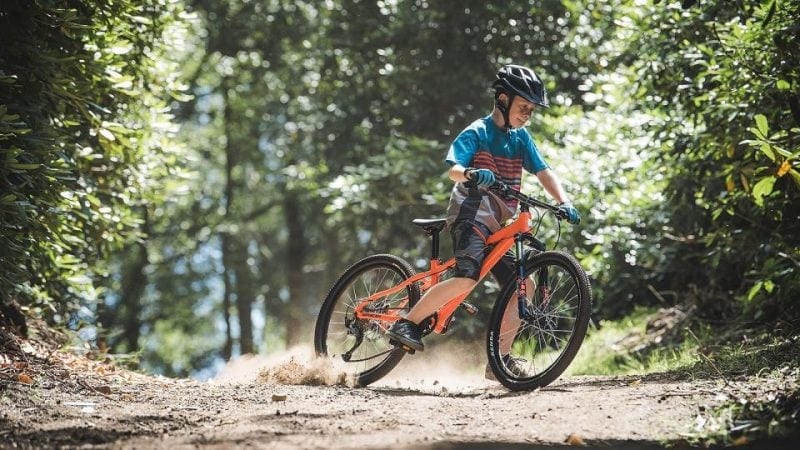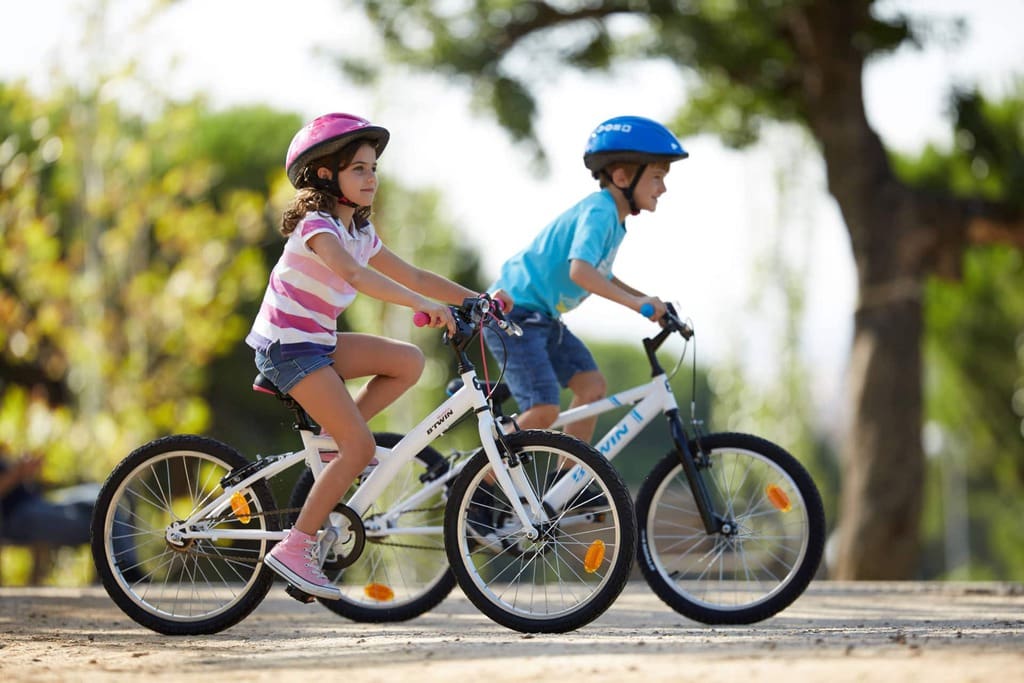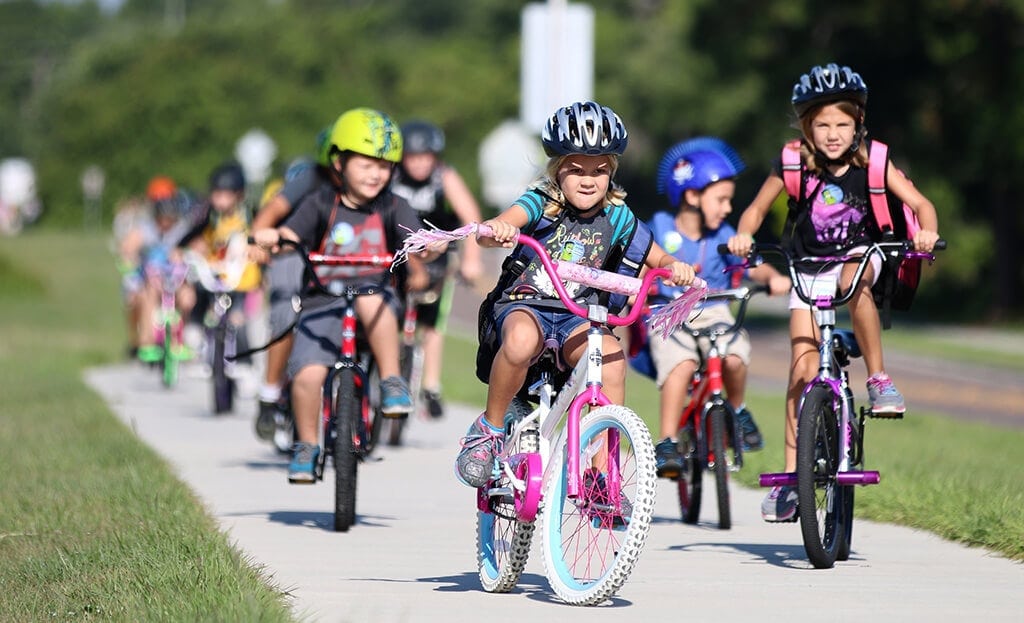17 Safety Tips for Kids Riding A Bicycle
Cycling is a great physical activity for kids because it keeps them active, allows them to see their community in a new way and offers the whole family a chance to participate in a fun activity together.
But cycling doesn’t come without safety concerns. Even as communities plan their cities to be more bike friendly, cars on the roads and unexpected barriers are still a legitimate concern.
It’s absolutely vital you educate your kids on how to stay safe while they’re traveling on two wheels. And this goes beyond looking for both ways before crossing a street.
Here’s a comprehensive list to help you keep your kids safe before they enjoy their next adventure on a bike.
On This Page
Ride A Suitable Bike Size
A bike too big or too small can actually be dangerous for your kid to ride.
Bikes that are too large aren’t only uncomfortable, but they can be difficult to maneuver because they’re typically heavier.
Bikes that are too small can make your kiddo feel constricted in the saddle. Their ability to hop off a bike quickly is hindered when they feel scrunched up on the bike.
Work with your local bike shop or pay attention to a manufacturer’s sizing guide to find the perfect sized bike for your child.
Of course, kids grow quickly, which means they may go through a few bikes until they’re fully grown. Waiting too long to upgrade to an appropriately-sized bike isn’t just potentially dangerous; the idea of going on a bike could be off-putting all together for them because it’s too uncomfortable.
Use Front and Rear Lights
There are a few accessories kids should have on their bikes and front and rear lights are at the top of that list.
Lights aren’t just for biking at nighttime. They can also help capture the attention of a car driver who might be doing something other than paying attention to the road.
Of course, in the event your child is out and about as the sun is setting for the day, having an easy-to-install light on the front handlebars and on the back of the saddle is the best possible way for not only motorists to see your child riding, but also for your child to see where they are going and what’s ahead.
A decent pair of lights can run you about $50.
Use Bells
It’s all too common for a crash to happen as one cyclist is passing a pedestrian or another cyclist. The bike rider feels like they have enough room to pass, but at the last second, the pedestrian moves over into the bike’s path and a crash occurs.
This scenario can be avoided with the use of a bell. Teach your kid to always ring the bell a couple of times and announce that they are going to pass. They should receive some sort of confirmation from the pedestrian or other cyclist, giving them permission to proceed with their pass.
This shouldn’t be a hard sell for your kid to use because kids love bells. Thankfully, bike bells are also relatively inexpensive, typically costing about $15 to $20.
Ensure Brakes are Working
It’s always a good idea for your kids to get into a routine of testing out their bike before taking off on their ride, even if it’s just in your driveway.
Most importantly, they need to do a check of their brakes. Have them pedal down the driveway and then perform a sudden stop by squeezing their brake handles. If the bike’s brakes are working, they should make a nice skid mark on your driveway. If they’re not, they’re going to know they can’t stop and, thankfully, they’ll only be in the driveway and not on a major road.
An easier test is to engage the brakes and walk the bike backwards. Properly working brakes will make it difficult to push the bike backwards.
Always Wear A Fitted Helmet
A helmet is your best protection against a serious head injury when riding a bicycle. It can prevent 85% of head injuries in the event of a crash.
But if that helmet is too loose, it’s not going to do a darn thing.
Always make sure your child’s helmet is properly fitted to his or her head. There should be very little wiggle room when it’s properly fitted and installed.
Conversely, make sure it’s not too tight to the point where it’s uncomfortable.
A good rule of thumb is that the skin on your head should move slightly as you move the helmet. That means it’s tight enough for the protection your child needs while on the road.
Read More : 9 Things to Know Before Buying Bicycle Helmets
Wear Bright and Visible Clothing
Wearing bright clothes is especially important when riding during darker hours of the day.
In the spring and fall, purchase your child a super-bright windbreaker jacket (laser green or bright orange will do!) to keep them warm, but also to make sure car drivers on the road see them.
Even better, purchase a bright-colored jacket or long sleeve with reflective strips on it. If car lights shine on your little one while riding, the driver will definitely see them on their bike.
At all costs, avoid wearing dark blacks and blues while out on a ride.
Read More : A Beginner’s Guide to Cycling Clothing
One Child Per Bike
This is more of a safety rule for middle school-aged riders who may think it’s a good idea to have a friend or sibling ride on their handlebars or hang on to their shoulders while they ride on a bike with wheel pegs.
We’ll make it simple for you. It’s a bad idea.
Unless it’s a tandem, kids’ bikes are designed for one rider at a time.
If you have two (or more) riders trying to squeeze onto the bike and there’s a crash, the injuries could be quite serious. Additionally, when there is more than one child on a bike, chances are slightly higher that at least one of those kids isn’t wearing a helmet.
Keep reminding your kids that only one child is allowed on their bike at a time.
Hands on Handlebars, Head Looking Straight
Your kids may see more experienced adult riders cruising around town with their hands off the handlebars, but that’s not a permission slip for them to also try it.
The safest way for your child to ride a bike is to keep his or her hands on the handlebars and their head pointed toward the path ahead.
Of course, kids are curious and one day they’re going to see if they can ride without their hands on the handlebars. The first time they do it, they’re undoubtedly going to fall to the ground because it’s an awkward sensation to not have control of the bike.
If they absolutely must try this stunt, take them to a grassy field to make the inevitable fall include a softer landing.
Avoid the Sidewalk if Possible
Many parents might think the safest place for their children to ride is on the sidewalk. But if you live in a subdivision or neighborhood where there are many driveways that cross sidewalks, you’ll actually want to ride in the road.
When you’re riding on the sidewalk, you could potentially be in the blindspot of a car that’s pulling out of a driveway. There’s a higher chance that person stops before pulling into the street to look for other traffic in the road as opposed to stopping at the sidewalk for pedestrians or bicyclists.
Now, if you live in a neighborhood where there are minimal driveways, a sidewalk could be a safer option, especially for younger children and toddlers.
If you can, though, teach your kids at an early age how to ride on the road. Afterall, bicycles follow the rules of the road and can’t pick and choose between the sidewalk and the road.
Get Away from the Traffic
If you’re really concerned about road traffic, then go find a nice park or bike path.
Thankfully, more and more communities have invested in multi-use, non-motorized trails for runners and cyclists. This is the perfect place to take your child to bike as they only have to worry about pedestrians and other cyclists.
Even traditional city parks tend to have a sidewalk that loops around the land, which also works for your child to bike.
Don’t Ride in the Dark
This might be self-explanatory, but riding after the sun turns in for the night increases the chances of an accident.
In fact, more than half of biking accidents happen in the dark. Unfortunately, many of these accidents are bike vs. car accidents, which tend to be quite serious.
To see this rule through, give your kid a biking curfew that prohibits them from biking between dusk and dawn.
Ride in A Straight Line
For some reason, kids love swerving left and right while on a ride. This can be dangerous in the event they swerve into oncoming traffic.
Teach your kids the importance of riding in a straight line to avoid any accidents.
To help them, you can set up a course in your driveway using sidewalk chalk. Encourage your child to ride on the dotted line as straight as possible. This will build up their balancing skills and help them ride a little straighter when they hit the road.
Read More : 6 Effective Tips to Teach Kids to Ride A Bike
Stay Alert
Technology is everywhere today, which can make staying alert while on a bike even more difficult.
Remind your children to never wear headphones while riding their bike and to always pay attention to what’s in front of them. Of course, that includes not having them pull out their cell phone to look at a text message or make a phone call.
Remind your kids that bike rides tend to be short trips and they can check all of their things once the ride is over.
Walk the Bike Across Intersections
This isn’t as important in small-town neighborhoods, but in busier cities, it’s always a good idea to walk the bike across busy intersections.
The idea is that riding your bike across is more unpredictable. What happens if you fall off and get injured and, all of a sudden, traffic is making its way toward that intersection?
By walking, you’re simply making your trip safer.
For younger children, you should plan your routes to avoid intersections, but we understand that’s not always possible. That’s why it’s important to instill early on that it’s OK to walk with your bike in order to be more safe.
Use Hand Signals
Cars use turn signals. Bikers use hand signals.
As you teach your children how to safely ride a bike, you should also teach them the proper hand signals to alert motorists which direction they’re turning. Here’s a refresher of those hand signals :
- Left arm straight out – Turning left.
- Left arm cocked at a 90-degree angle – Turning right.
Encouraging them to use hand turn signals can actually turn into a fun game for your children.
Don’t Lose Sight of Them
This is especially true with toddler bike riders. You should always keep an eye to ensure they’re stopping at stop signs, staying on their side of the road and, most importantly, paying attention to all of the traffic in the road.
When it comes to biking, you don’t have to worry about being a helicopter parent. You’re only making sure your children are being as safe as possible.
Lead by Example
If you want your child to be a safe bike rider, you need to act like a safe bike rider.
This means that you…
- Always wear your helmet (even on short rides!)
- Stop at all stop signs.
- Walk your bike across major intersections.
- Use hand signals to show where you’re turning.
Your best course of action is to always lead by example.
The good news is, these safety tips just don’t apply to children. They’re quite relevant for all riders, so by encouraging your child to follow these rules and following them yourself, your whole family is going to be extra safe when enjoying a family bike ride.
Author Recommended Reads



